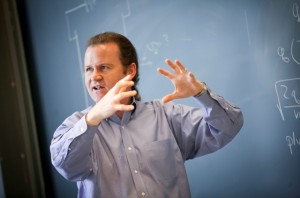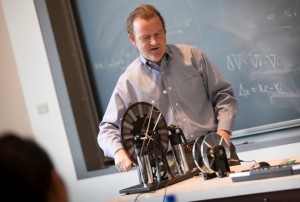
David Nice
For David Nice, associate professor of physics, passion for his field came naturally.
“I’ve always been interested in how things work and physics is all about how things work at the most fundamental level,” he says. “I love astrophysics research in particular because it often involves simple, straightforward physical ideas, but we can learn fundamental things by applying these ideas. I find it exhilarating to use telescopes to make new measurements, to discover new stars, and to measure new things from known stars.”
Much of Nice’s research focuses on pulsars, or fast-spinning stars that have reached the ends of their “ordinary” lifetimes.
“Pulsars are extreme objects by any measure: They are more massive than the sun, yet they can spin around tens or hundreds of times a second. Pulsars emit regularly spaced trains of pulses that we can detect using radio telescopes,” says Nice, who uses telescopes in Puerto Rico and West Virginia that can be operated remotely using computers at Lafayette to complete his research.

David Nice
Nice is part of an international group of physicists that received a $6.5 million, multi-institution grant from the National Science Foundation (NSF) for research on applications of pulsar observations. Lafayette’s portion is $145,884.
The group is seeking to directly detect gravitational waves, which Nice describes as “ripples in spacetime that are a prediction of Einstein’s theory of general relativity.” As pulsar signals travel through space from the pulsar to the Earth, ripples affect their motion and they can end up arriving at telescopes a little earlier or a little later than they otherwise would.
This research is significant because it will open up an entirely new spectrum for studying the universe. With pulsars, this group of physicists is working to detect slow-changing waves with periods of several years. No one has yet successfully directly detected gravitational waves, but Nice is hopeful that it will happen soon and that their observations of the gravitational wave spectrum will bring new information about the universe.
“Signals from a typical pulsar that we observe take several thousand years to reach us,” he says. “The gravitational waves probably perturb their travel times by less than 100 nanoseconds, so we will have to measure pulsar signals with exquisite precision in order to detect the effect of the gravitational waves. By improving the precision of our telescope measurements, by increasing the number of pulsars under observation, and by pooling our resources with other astrophysicists around North America and around the world, we hope to be able to directly detect gravitational waves within a few years.”
The schools involved in the five-year NSF grant are West Virginia University, Cornell, University of Vermont, University of Texas (Brownsville), University of Wisconsin (Milwaukee), Oberlin, Franklin and Marshall, and the National Radio Astronomy Observatory. One of the purposes of the grant is to broaden collaborative work not just among the institutions receiving grants, but also with colleagues worldwide working in this field.
“We have close collaborations with astrophysicists at other institutions in North America, and we are working on pooling resources with researchers throughout the world (Australia, England, Germany, etc.),” says Nice, who earned his Ph.D. and M.A. from Princeton University.
Some of the group’s research was published in April in The Astrophysical Journal article “Arecibo PALFA Survey and Einstein@Home: Binary Pulsar Discovery by Volunteer Computing.”
Nice, who started at the College this past year, chose Lafayette because of the supportive environment for research.
“I came here because I want to be at an institution where I can work closely with students,” he says, “where I can teach courses which are rigorous, illuminating, and exciting, and where I can undertake cutting-edge research.”


1 Comment
Comments are closed.